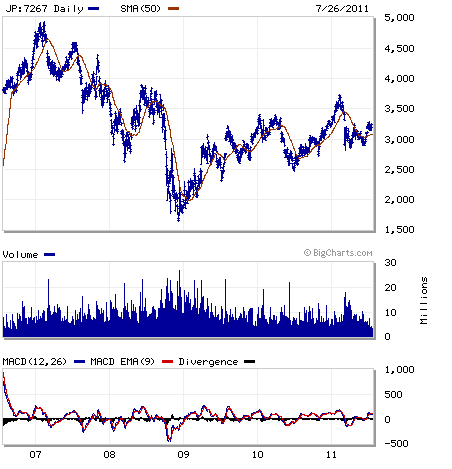 With volatility taking its toll on equity markets, investors are once again frustrated, frightened and outright bewildered. Both retail and institutional investors are questioning why fundamental research and investment analysis even matter, when markets are so often swayed by a multitude of exogenous and unpredictable variables that have nothing to do with company specific fundamentals. In March of this year, a deadly tsunami spawned by a violent earthquake swept Japan’s eastern coast, inflicting havoc not only on that region, but also on the psyche of the global financial markets, which suffered tremendous losses as a result. Then just as investors’ confidence recovered in early May, major US and Canadian indices suffered another bout of painful declines, the result of a sell-off in the energy sector stemming from announcements of larger-than-expected crude oil inventories, which spilled into other markets. This has been followed by nearly six weeks of broad market declines fuelled by concerns over everything from a slowing US economy and rising unemployment to growing sovereign debt issues in much of the developed world. With mounting investor anxiety stirred by weak economic data, I would ague that fundamental research focused on finding financially attractive targets (FAT) in these uncertain times is even more important to long-term investment success.
With volatility taking its toll on equity markets, investors are once again frustrated, frightened and outright bewildered. Both retail and institutional investors are questioning why fundamental research and investment analysis even matter, when markets are so often swayed by a multitude of exogenous and unpredictable variables that have nothing to do with company specific fundamentals. In March of this year, a deadly tsunami spawned by a violent earthquake swept Japan’s eastern coast, inflicting havoc not only on that region, but also on the psyche of the global financial markets, which suffered tremendous losses as a result. Then just as investors’ confidence recovered in early May, major US and Canadian indices suffered another bout of painful declines, the result of a sell-off in the energy sector stemming from announcements of larger-than-expected crude oil inventories, which spilled into other markets. This has been followed by nearly six weeks of broad market declines fuelled by concerns over everything from a slowing US economy and rising unemployment to growing sovereign debt issues in much of the developed world. With mounting investor anxiety stirred by weak economic data, I would ague that fundamental research focused on finding financially attractive targets (FAT) in these uncertain times is even more important to long-term investment success.
The central theme behind finding financially attractive targets is that each opportunity has to be economically scrutinized based on the value received in comparison to the price paid. Given that all investment decisions should be economically scrutinized in such a manner, a reliable investment process must therefore be heavily based on the concept of value, deciphered through fundamental analysis. To do otherwise simply cannot be classified as investing.
I would further postulate that an investment purchase should be treated differently than most other buying decisions, as it needs to be held to a higher level of due diligence. It is quite surprising how much time an individual will dedicate to comparing the features and prices of a new television, mobile phone, or bargaining with the sales agent when deciding to buy a new dress or suit, yet when the decision concerns a stock investment one closes the deal with little or no knowledge of the company’s business, operations, or history.
Determine Worth
Nonetheless, while determining the worth of an investment is no trivial matter, the effort is often well spent in comparison to the alternative of investing blindly and suffering a permanent deterioration of principal. At a basic level, an investor should at least know what the company does. Asking simple questions can increase your understanding of a potential investment opportunity. Questions such as:
- What kind of product(s) does the company make or service(s) do they render?
- Is there an increasing trend in demand for the product or service?
- What does the competitive landscape look like?
- What are the assets on the balance sheet worth?
- How much debt is on the balance sheet?
- How much free cash flow does the company generate?
- What is the company’s dividend policy?
- How much is the company expected to earn in the future?
While these questions are a good start, there are many other inquiries pertaining to the company’s financial statements and management capabilities that should be made in order to place a value on the business. In my experience, the required analysis is a combination of art, science, and philosophy among other disciplines, which allows one to peer into historical facts and understand the behaviours and motives of various stakeholders. With a fair or intrinsic value in hand, you are in a much better position to make an investment decision, in any market environment.
Buy at a Discount
Ideally, as an investor your goal is to buy a business at a meaningful discount to the intrinsic value. There are two factors at play here. First, if your estimates are correct, you increase your return potential by purchasing the stock at a lower price. Second, and most important in my eyes, if you are incorrect and have underestimated the fair value, you reduce the loss potential because you have an added margin-of-safety built in. The concept of margin-of-safety focuses on a central doctrine in value investing, as espoused by Warren Buffett and other value oriented investors; never lose money. Of course this is easier said than done.
Be Patient
General market malaise can cause your investments to deviate widely from their true, private market valuations. So, you may have to sit patiently until the market recognizes your original investment thesis. While the departure of the current market price from the company’s intrinsic value is what created the investment opportunity, the process by which the market realizes this mispricing and its correction thereafter varies. The situation may be corrected quickly due to an event such as an earnings announcement, which confirms that the company is still quite profitable after suffering a previous, but temporary weak performance period. However, the mispricing may take a gradual path as market participants little by little realize that the company’s prospects are positive and that it is in fact worth more than the present market value.
Again, the key is to be patient while continuing to monitor and analyze company fundamentals for any signs that indicate that your original investment thesis may have changed. If everything remains the same, it makes sense the stay with the investment—remember why you bought it in the first place. Imagine the feeling you would get if you found out the person you recently decided to divorce won millions in the lottery. Its synonymous to the situation where you buy a stock based on sound fundamental reasoning, hold on to it for months or even years, then one day you spring out of bed and decide to sell it based on a sudden irrational thought, or fear-induced market panic. Shortly thereafter, the company announces that the strategic initiatives they had put in place a while back are starting to show up in revenues and earnings, the stock price begins to climb; you now face a more tormenting decision whether to get back in. Asking what the business was worth before the sale might have prevented the agony.
Unfortunate Disaster of Japan Earthquake and Fukushima
Quality companies can get caught in the downdraft of wide spread market panic. There is no guarantee that companies with solid fundamentals will not temporarily be thrown out with the dogs during times of extreme volatility, however this presents an opportunity to acquire financially attractive targets.
As an example of how market psychology can weigh on valuations, the tragic earthquake that occurred earlier this year in Japan had an immediate affect on Japanese stocks. The Nikkei fell more than 6% the Monday after the earthquake, which happened on the Friday. At first, investors assessed the situation as mainly a Japanese concern, since elsewhere in the region reaction was relatively muted and exchanges in South Korea, Hong Kong, Singapore showed only modest declines. The response was pretty much the same in North America and Europe.
It was not until the following day as fear of a nuclear crisis mounted from an announcement that radioactive material had leaked from the Fukushima nuclear plant, that we witnessed wide scale panic selling and pronounced declines on stock markets around the globe, with the Nikkei falling an additional 11%. As fears continued to escalate it became difficult for investors to think rationally through the cacophony of news briefs; they simply could not imagine how companies such as Nissan, Honda, and Canon will ever recover.
Honda (TYO) Out of Favour
To continue, Honda (TYO), Japan’s third largest automobile manufacturer fell by approximately 10% over the period in discussion. With a history dating back to the 1930s, the company is well known for producing reliable cars. Honda has industry leading return on equity (a key metric in analyzing profitability), and the lowest debt situation of the top Japanese car producers. With a current trailing twelve month P/E (price-to-earnings) ratio of 11, the company appears to be a worthy addition to any global portfolio. The company has navigated its way through the plethora of market upheavals this year and has already recovered nearly the entire price decline since March. As to when Honda’s stock price will reach new highs, no one can give an exact date, but I do know that people will continue to drive Hondas for a long time to come.

Conclusion
In summary, market turbulence, deriving from political events, natural disasters, and economic data can lead investors to a heightened sense of despair and cause them to question the merits of fundamental research. However, it is precisely at these times that investors need to remain disciplined, maintain the right temperament in order to wade through disorderly markets and remember that all economically scrutinized investment decisions are based on an assessment of the intrinsic value received relative to price paid. The process is time-consuming and requires a great deal of patience but it is the only way to consistently find sound investment opportunities – or better said, financially attractive targets (FAT) – and reap the rewards over the long-term.
Garnet O. Powell, MBA, CFA
I am honoured to have been able to share with you my thinking on the investment process and would be delighted to hear your thoughts.

